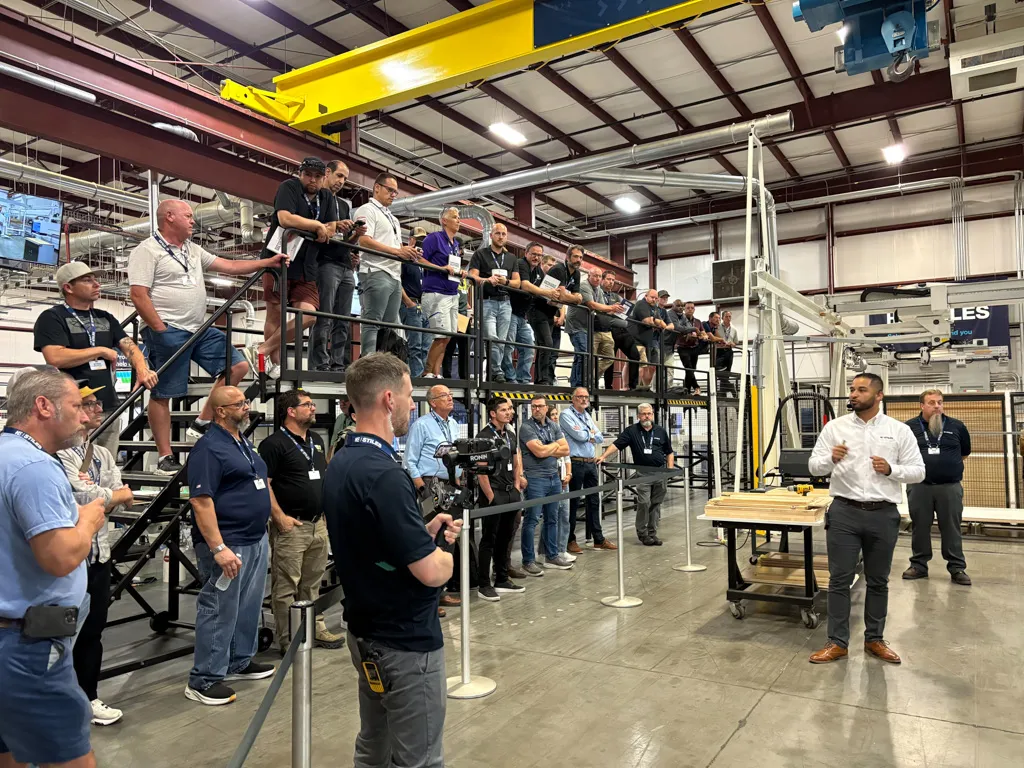Table of Contents
North American Manufacturers Get Invaluable View On Upcoming Trends
Grand Rapids, Mich. — As 2017 gets into full gear, manufacturers who participated in the Stiles European Benchmarking Tour are factoring in their experience abroad to shape their future strategies and growth plans.

The annual technology tour through Austria, Switzerland and Germany in fall 2016 immersed attendees in batch-size-one production, intelligent storage and retrieval systems, robotics and materials flow — offering a personalized preview into trends that are beginning to influence the North American furniture market.
The 2016 tour brought together a wide-ranging group of about 30 North American manufacturing executives of store fixtures, cabinets, closets, lockers and other furniture to explore the unique processes, strategies and business plans of five of the most innovative, efficient and productive manufacturing facilities in Europe. Over a week, participants explored not only technology, but also how these companies overcame challenges, bottlenecks and cultural changes and discovered new ways to think about their own operations.
Plant tours ran the gamut from top producers of kitchen cabinets, medical, commercial and institutional furniture to store fixtures, including:
• Hali Betriebs GmbH in Eferding, Austria, is one of the largest office furniture manufacturers in Austria, manufacturing in a 250,000-square-foot facility. The company uses batch size one processes to produce office furniture in more than 48 million possible variations in just 15 days from order to delivery.
• Loosli Küchen AG in Wyssachen, Switzerland, produces kitchen and bathroom cabinetry using a wide variety of materials, finishes and thicknesses, with only 7 percent waste. The company is in a 10,000-square-foot facility, and the focus is on creative use of space, including a fully automated 32-level storage and retrieval system to hold finished jobs until shipping.
• Alpnach Küchen AG in Strengelbach, Switzerland, produces 1,200 styles of kitchen cabinets in its 6,000-square-foot plant. To produce about 2,000 kitchens per year, the company essentially eliminated the need for material storage by focusing its manufacturing on cabinet doors and bringing in pre-cut carcasses for edgebanding, drilling and assembly.
• Kettnaker GmbH & Co. KG in Dürmentingen, Germany, designs and manufactures high-end modular furniture systems for living rooms and bedrooms using batch size one processes. The plant is notable for using no melamine in its cabinets and applying lacquer and veneer finishes in house.
• Ziefle Koch GmbH in Waldachtal, Germany, produces furniture for instructional and educational facilities, clinics, medical centers and restaurants, working in a wide range of unusual materials.
Because European manufacturing technologies and strategies tend to lead those of North American manufacturing practices by five to eight years, the annual technology tour allows North American manufacturers to benchmark themselves against companies in similar business situations and with similar limitations, including limited manufacturing space, density in local markets and labor challenges. Seeing trends in efficiency, optimization and automation gave the group great insight to the future of their manufacturing.

Material handling
Improvements in material handling allow manufacturers to increase production speeds and better control production flow and sequence to ensure that all of the parts for a particular job come out together at the same time, ready for assembly, regardless of the processes required for individual parts. Some parts, for example, don’t need to be drilled, just run through the cutting and edgebanding lines, but they need to be held and kept together with parts that are drilled and machined. Integrated software systems, such as enterprise resource planning (ERP), are critical to tracking and managing the movement and processing of parts and panels.
Hali Betriebs, for example, made a large investment in material handling equipment, including a two-story storage and retrieval system, as well as buffering and sorting systems to balance the lines, timing the movement of pieces and parts through one of the company’s production lines so that the entire job is delivered for assembly at the same time. To save money and time, the company eliminated labeling on the more than 20,000 parts per week moving through this line. Instead, machinery detects and identifies parts by size, shape, and sequence. (A second production line does use labels.)
Intelligent storage and retrieval
Another aspect of material handling, storage and retrieval systems are increasingly managing the inventory of sheet materials and board storage based on upcoming jobs. Driven by ERP, even before the  first cut, these systems know exactly how long each part will be in any given production cell and where bottlenecks will occur, and they are timing everything to make sure that the entire job completes together.
first cut, these systems know exactly how long each part will be in any given production cell and where bottlenecks will occur, and they are timing everything to make sure that the entire job completes together.
Loosli Küchen, operating with limited production space, implemented both a two-level storage and retrieval system for materials and a 32-level fully automated storage and retrieval system exclusively for finished furniture. The company manufactures about 1,100 cabinets each day, which are loaded immediately after completion into automated storage and held there until they are shipped, freeing the company’s small floor space for production.
Robotic handling
Taking a different approach, Alpnach Küchen, which produces about 2,000 completely customized kitchens each year in 6,000 square feet of space, eliminated the need for a storage and retrieval system by purchasing pre-cut carcasses for its cabinets. Only the cabinet doors are cut on site. Alpnach does use a highly automated edgebanding line, with three robotic gantries feeding, stacking and repositioning materials. The company’s use of robotic handling and production control make it possible for high volume production in this cell with just three operators.
Kettnaker employs a robotic feeding system to the plant’s edgebanding line, using robotics to sort, position and handle the parts for its high-end modular furniture systems. The edgebander actually drives the process, dictating which materials the gantries pick up, how they are repositioned for edgebanding and on which pallets the parts are stacked so that they are ready to move with the rest of the job. The critical element is the integration of software and communication between the gantries and the edgebanding lines.
Batch size one
Ultimately, all of these improvements contribute to the goal of batch size one production — using industrial processes to produce customized store fixtures or furniture items to meet an individual customer’s requirements. North American companies are, in general, just beginning to show interest in batch size one processing, with the more  forward-thinking companies beginning to adopt it in incremental phases.
forward-thinking companies beginning to adopt it in incremental phases.
Chris Dolbow, marketing manager at Stiles Machinery, said: “While many assume that implementing this type of approach is only for large companies, when it comes to batch size one, companies with just four or five employees can benefit as much — or more — than larger companies.
“The process doesn’t have to be the same for every company – it just has to work for you, for your particular challenges and for your people,” Dolbow said. “Implementing batch size one can be scalable to the situation.”
Hali Betriebs, for example, began its batch size one project in 2009, starting with its cut-to-size processing, then moving to edge processing and buffering and finally to drilling and sorting.
Thinking differently
The benefits of the tour go far beyond seeing high-tech equipment at work. Even seeing small improvements that participants can make to their own operations can make the trip worthwhile. How a company stacks equipment, for example, organizes parts before assembly or categorizes materials, tooling and supplies can inspire creative solutions back home. Transfer carts were another area of interest, often built by the plants to meet their specific needs.

Many European companies face severe space limitations, similar to those encountered by manufacturers based in the U.S. Northeast. Loosli Küchen, with a limited footprint for production, carved out a cell below ground level to house its seamless edgebanding line. The company also took a 60-by-30-foot area and went vertical to create storage — something that most in North America wouldn’t typically consider.
David Dunigan, president of Modern Store Equipment, based in Burlington, N.J., was one of the participants in this year’s tour. His company faces similar challenges to those of the European companies he toured.
“Both labor and space are expensive,” he said.
Modern Store Equipment, which specializes in liquor stores from the ground up, shares a 24,000-square-foot building between the shop and a warehouse for the company’s distribution business. The company already takes a batch size one approach to manufacturing, so he found the trip relevant.
“Since we have a small space, we don’t want to have jobs sitting in the warehouse either coming in or going out, so we basically run what we need that day—or at least that’s the goal,” he said.
New technology, particularly the robotics used in the plants and at Holzma’s and Homag’s plants, were of particular interest.
“I don’t think we’re quite there yet, but they had some really impressive stuff that we’re thinking about for our next step,” Dunigan said.

Four ideas to take from the trip
1. Think about what will affect your business in the future. What materials will you be working with in five years? Will you need to size the same types of parts? Will production flow change? Will you even need a saw?
2. Build on your limitations. Some of the plants that participants were most impressed with were also those that might at first glance appear to be operating under the most challenging conditions. Be creative!
3. If labor is a limitation, removing labor from a process also reduces the opportunity for operator error. In many European plants, even large production cells, whether cut-to-length, edgebanding, or drilling, can be managed with one to three operators. (In the U.S., 10 to 15 operators might be required for similar operations.)
4. Don’t just replace a machine when it needs to be replaced. Make a plan for where you’d like your company to be in five, eight, or 10 years. Then look at what equipment, software and strategies will help you get there. In one year, that might mean putting in place new software, then in another, making changes to a cutting line or an edgebanding line. Take incremental steps toward a smarter and more efficient production strategy.









